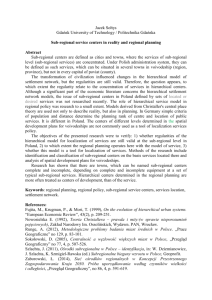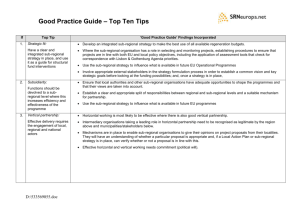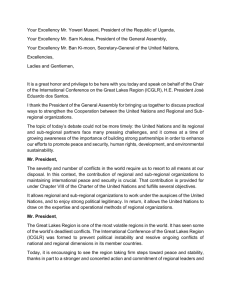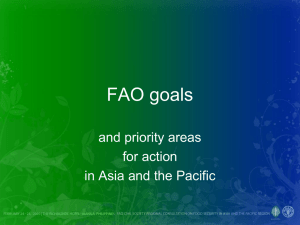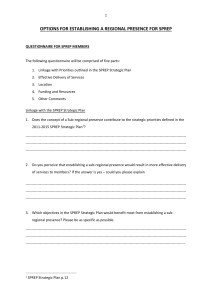Excerpt from Avon Sub-Regional Economic Strategy
advertisement
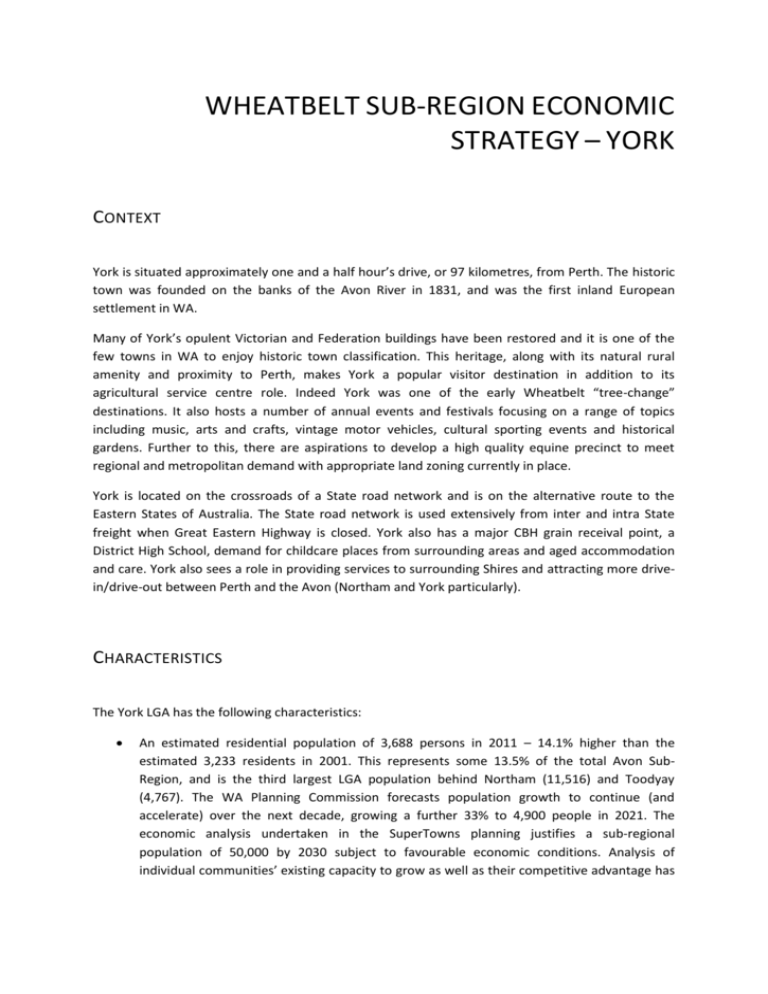
WHEATBELT SUB-REGION ECONOMIC STRATEGY – YORK CONTEXT York is situated approximately one and a half hour’s drive, or 97 kilometres, from Perth. The historic town was founded on the banks of the Avon River in 1831, and was the first inland European settlement in WA. Many of York’s opulent Victorian and Federation buildings have been restored and it is one of the few towns in WA to enjoy historic town classification. This heritage, along with its natural rural amenity and proximity to Perth, makes York a popular visitor destination in addition to its agricultural service centre role. Indeed York was one of the early Wheatbelt “tree-change” destinations. It also hosts a number of annual events and festivals focusing on a range of topics including music, arts and crafts, vintage motor vehicles, cultural sporting events and historical gardens. Further to this, there are aspirations to develop a high quality equine precinct to meet regional and metropolitan demand with appropriate land zoning currently in place. York is located on the crossroads of a State road network and is on the alternative route to the Eastern States of Australia. The State road network is used extensively from inter and intra State freight when Great Eastern Highway is closed. York also has a major CBH grain receival point, a District High School, demand for childcare places from surrounding areas and aged accommodation and care. York also sees a role in providing services to surrounding Shires and attracting more drivein/drive-out between Perth and the Avon (Northam and York particularly). CHARACTERISTICS The York LGA has the following characteristics: An estimated residential population of 3,688 persons in 2011 – 14.1% higher than the estimated 3,233 residents in 2001. This represents some 13.5% of the total Avon SubRegion, and is the third largest LGA population behind Northam (11,516) and Toodyay (4,767). The WA Planning Commission forecasts population growth to continue (and accelerate) over the next decade, growing a further 33% to 4,900 people in 2021. The economic analysis undertaken in the SuperTowns planning justifies a sub-regional population of 50,000 by 2030 subject to favourable economic conditions. Analysis of individual communities’ existing capacity to grow as well as their competitive advantage has resulted in a proposed population distribution of 7,000 residents in York (equating to an annual growth rate of 6.6%). 18.2% of the estimated residential population is aged 14 years or younger – consistent with that of the Perth Metropolitan Region (18.6%) and WA (19.7%) average. 19.3% of the population is aged over 65 years, which is significantly higher than the WA average (12.3%). Consistent with other sub-regional LGAs and the majority of WA, York is expected to experience significant ageing in the population over the coming decades, with 22% of the population aged over 65 years in 2021, and 25% in 2031. Median personal income levels ($24,856) are in line with the sub-regional average ($24,851). A household income growth rate of just over 4.5% per annum over the period 2001 to 2011 was higher than a number of other sub-regional LGAs, although much lower than the WA average (at over 6% per annum). From a price base of $250,000 in 2006, median house prices grew by 21% to $302,500 in 2011 (the second highest median house price in the sub-region behind Toodyay). This is broadly in line with average growth rates of the wider Avon Sub-Region (22.5%) but higher than the State average (15.2%). It is noted however, that significant variation was experienced across the different LGAs depending on base price levels (with York starting from a higher base than many other LGAs). Current household income levels and house prices indicate that York is the least affordable LGA in the Sub-Region, with a house price to income ratio of 6.41 and the next highest being Toodyay at 5.99. This ratio is also higher than the WA average at 5.98. Agriculture remains a significant contributor to York’s economy, accounting for 38% of registered businesses in 2009. The Shire comprises some 136,135 ha of agricultural land holdings (accounting for 8% of the Sub-Regional total), generating approximately $46.2M in production value per annum (approximately 11% of the Sub-Region). On a per hectare basis, York generates the highest rate of production value ($339/ha) than the Sub-Regional average ($254/ha), owing to diversity in crop types with higher yield volumes and price returns (e.g. wine and olive production in addition to grain crops). Tourism plays a significant role in the York economy, with some 172,505 tourists visiting the Shire every year on average – the second highest average annual visitor count behind Northam which attracts 207,099 visitors (although York has more than double the rate of tourists per head of population - 53.4 in York compared to 20.2 in Northam). 79% of the Shire’s visitors are comprised of day trippers, reflecting York’s relatively close proximity to Perth, although this figure is lower than other major sub-regional visitor destinations such as Toodyay (84%) and Northam (83%), suggesting that York is a more attractive destination for overnight stays. Manufacturing, transport & logistics accounts for 5.2% of local businesses in York, and the 109,606ha of zoned industrial land in the LGA represents 4% of the Sub-Regional area total. York also has a secondary retail role, given its relatively large residential population base, with 7.1% of locally registered businesses operating in the retail sector. Given its role as a sub-regional population centre and proximity to Perth, York has a relatively good provision of community services and facilities. There are currently 15 public hospital beds provided in the town (16% of the sub-regional total), along with 28 aged care beds (18% of the sub-regional total). Primary and secondary public education services are provided by York District High School (390 primary and 84 secondary students), whilst the town also has a library and child care centre. ECONOMIC OPPORTUNITIES The following economic opportunities have been identified: BROADACRE AGRICULTURE As expected, broadacre agriculture represents the most distributed economic opportunity in the Avon and is likely to remain the foundation industry of the sub-region in the medium and longterm. York will continue to serve a primary production role given the amount of agricultural land available, high cropping yields, and local support infrastructure. Given its close proximity to Perth and strong transport connections to other sub-regional centres, York has an opportunity to play a greater role in the storage, transportation and administration of agricultural products. HEALTH & AGED CARE The distribution of economic opportunities in health and aged care is primarily determined by a combination of current and short-term population ageing and the distribution of existing health facilities. Although relatively close to Northam, York is projected to experience considerable population growth and there are opportunities to leverage the town’s existing health facilities to provide convenient and flexible health services to all age cohorts, particularly for older residents given the projected ageing of the local population. RETAIL & LIFESTYLE Whilst the sub-regional retail network is and will continue to be centred on Northam (representing the largest concentration of population and floorspace in the Avon), York will continue to experience both population and visitor led increases in local retail demand, with lifestyle and tourism drivers underpinning growth. The projected ageing of the local population will also reinforce the need for local retail activity, given the reduced ability and/or willingness of older residents to travel on a regular basis to other towns for shopping and lifestyle activities. TOURISM These is a strong spatial relationship between retail and tourism opportunities, reflecting the role that lifestyle, amenity and Perth proximity drivers play in the distribution of this economic activity. In addition to its proximity to Perth, York’s well documented heritage significance and local rural amenity are key advantages for the further development of local tourism activity. While it is expected that the daytrip market will continue to dominate local tourism activity in York, there are also opportunities to capture a greater share of “Grey Nomad” domestic tourism due to its level of accessibility and existing accommodation facilities. TRANSPORT AND INDUSTRY There exist strong drivers supporting transport, logistics and light industry investment and activity in the Avon sub-region, with spatial analysis identifying a “ring” of industrial opportunities comprising Northam, York, Quairading, Cunderdin, Dowerin and Goomalling. In the case of York, the opportunity exists to further develop its role as a secondary industrial node by capitalising on its strong transport links and relative proximity to Perth, offering support and distribution/logistics services for wider sub-regional agricultural activity. ACTIONS A series of actions require implementation for the Shire of York LGA to effectively leverage the economic opportunities identified above. A southern bypass road has been identified as required to optimise York’s geographic and industrial role in the transport “ring” mentioned above and cater for increased heavy transport traffic. This will also be essential to preserve the town’s heritage infrastructure and increase residential and commercial amenity. Upgrade of energy distribution infrastructure to facilitate industrial, residential and commercial development. Expand local tourism offerings and provide development flexibility for investment in the sector to optimise current sub-regional competitive advantage in York’s tourism profile. This includes, but certainly is not limited to, the Town Hall redevelopment and improved visitor servicing. Given the current demand, high percentage of young families, low unemployment rate, and opportunities to have underemployed share of the population enter the workforce (e.g. parents) there is a need to offer increased child care services. Investment in preparing development-ready and serviced light industrial land to optimise increasing private investment interest (preliminary surveying and business planning is underway for a 130 ha light industrial area in York). Expansion of current aged care offerings to complement an existing local economic driver, service a significant and growing aged proportion of the population, and to complement the greater Avon health and aged care sector. Provision of greater retail space in the town centre to allow for expansion of a number of existing businesses and to accommodate external investment interest. Expand sewerage infill infrastructure in a timely and cost effective implementation model.
